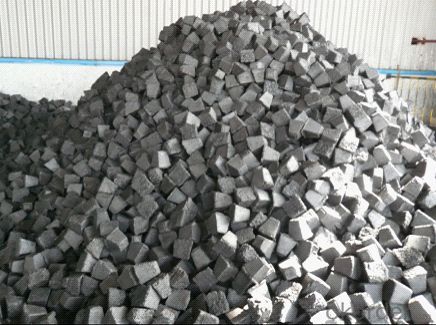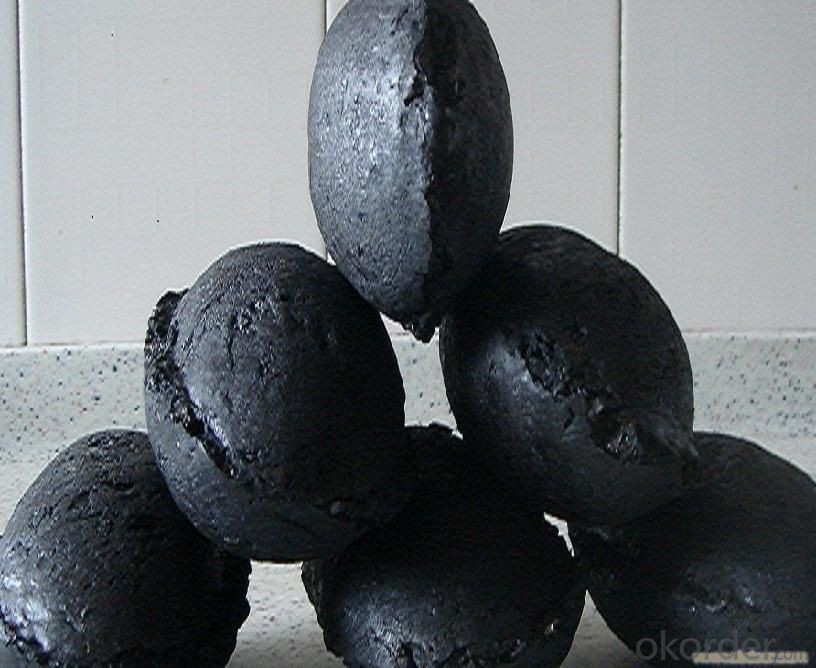China-Made Low Ash Carbon Electrode Paste -Ash7
- Loading Port:
- China main port
- Payment Terms:
- TT OR LC
- Min Order Qty:
- 0 m.t.
- Supply Capability:
- 20000 m.t./month
OKorder Service Pledge
OKorder Financial Service
You Might Also Like
Packaging & Delivery
| Packaging Details: | 1 mt bag or bulk package |
| Delivery Detail: | 15-30 days after we get the deposit or original L/C |
Specifications
1)Low ash content
2)Good thermal conductivity
3)High resistance to temperature
4)Stable quality
Main Function And Features
1) Low ash content
2) Good electric and thermal conductivity
3) High resistance to temperature
4) Stable quality
5) Reasonable price
6) Size:all kinds of electrode paste
7) Accord customer's reques change
Introduction To Products
1) Carbon Electrode Paste is a self-baking electrode used in submerged arc furnaces for delivering power to the charge mix.
2) Electrode Paste is added to the top of the electrode column in either cylindrical or briquette form.
3) As the paste moves down the electrode column the temperature increase causes the paste to melt and subsequently bake
forming a block of electrically conductive carbon.
4) Electrode Paste is essentially a mix of Electrically Calcined Anthracite (ECA) or Calcined Petroleum Coke (CPC) with Coal
Tar Pitch.
Application Range
1) Be used as the electrode for self roasting in the iron-alloy furnace and acetylene furnace.
2) Amorphous graphite powder--applied in steel making,fireproof material,casting coating.
3) Calcined petroleum coke--used in foundry,metallurgy,carbon paste,graphite electrode.
4) Carbon anode scrap--used as smelting fuel for copper smelting industry.
5) Carbon electrode paste--applied in iron alloy,calcium carbide,ferroalloy,ferromanganese.
Graphite/Carbon Electrode Paste
Specification/Item | |||||||
Ash | max | 4.0%max | 5.0%max | 6.0%max | 7.0% Max | 9.0% Max | 11.0% Max |
VM | % | 12.0%-15.5% | 12.0%-15.5% | 12.0%-15.5% | 9.5.0%-13.5% | 11.5%-15.5% | 11.5%-15.5% |
Compress Strength | Mpa Max | 18.0Mpa Min | 17.0Mpa Min | 15.7Mpa Min | 19.6Mpa Min | 19.6Mpa Min | 19.6Mpa Min |
Specific Resistance |
μΩm Max | 65μΩm Max | 68μΩm Max | 75μΩm Max | 80μΩm Max | 90μΩm Max | 90μΩm Max |
Bulk Density | G/CM3 Min | 1.38G/CM3 Min | 1.38G/CM3 Min | 1.38G/CM3 Min | 1.38G/CM3 Min | 1.38G/CM3 Min | 1.38G/CM3 Min |
- Q:Method for making carbon fiber board
- Our carbon fiber board adopts autoclave molding process, the product quality is good, no white spots, bubbles, lines and other defects, factory direct supply in bulk, at the same time to provide CAD customized processing services.Autoclave molding technology has the following remarkable advantages: high volume of fiber components, good quality stability, simple molding process
- Q:What are the different types of carbon-based air pollutants?
- Air pollution is caused by various types of carbon-based pollutants. Some examples include: 1. Carbon Monoxide (CO): This gas is produced when fossil fuels like gasoline, coal, and wood are incompletely burned. It is highly toxic and can be harmful to human health, especially when inhaled in large amounts. 2. Carbon Dioxide (CO2): This is a greenhouse gas that occurs naturally in the Earth's atmosphere. However, human activities like burning fossil fuels and deforestation have significantly increased its levels, leading to climate change and global warming. 3. Volatile Organic Compounds (VOCs): These are organic chemicals that easily evaporate at room temperature. They are released into the air by various sources such as paints, solvents, gasoline, and industrial processes. VOCs contribute to the formation of ground-level ozone, which is a major component of smog and can harm human health. 4. Methane (CH4): Another greenhouse gas, methane is primarily produced by the decomposition of organic materials in landfills and the extraction and transportation of natural gas. Methane has a much higher warming potential than carbon dioxide. 5. Polycyclic Aromatic Hydrocarbons (PAHs): These chemicals are formed when organic materials like coal, oil, and gas are incompletely burned. PAHs are released into the air through vehicle exhaust, industrial processes, and the burning of fossil fuels. They are known to be cancer-causing and have adverse effects on human health. 6. Formaldehyde (HCHO): This colorless gas is used in the production of resins, plastics, and certain building materials and household products. It is released into the air through fuel combustion, cigarette smoke, and the release of certain products. Formaldehyde is a respiratory irritant and can cause allergic reactions and other health problems. These are just a few examples of carbon-based pollutants that contribute to air pollution. It is crucial to reduce emissions of these pollutants by adopting cleaner technologies, energy-efficient practices, and promoting the use of renewable energy sources. This will help minimize their negative impacts on human health and the environment.
- Q:What is carbon coffee fiber?
- Its main functions are bacteriostasis, deodorization, divergence of negative ions and anti ultraviolet rays.
- Q:What are the problems that should be paid attention to in the injection molding of the material? Who has some details about carbon fiber injection? Thank you for sharing
- Carbon fiber melting point at about 3000 degrees (isolation oxygen, oxygen, about 400 degrees will be oxidized), itself can not be injection processing, only carbon fiber filled plastic can be injection molding.
- Q:Is aluminum alloy expensive or high carbon steel expensive?
- Here is a concept to be worked out:High carbon steel is more carbon in iron. The strength is better than general iron.Aluminum alloy is not pure aluminum, if it is pure aluminum frame, it can not be used as frame, aluminum alloy frame generally after T6 (T4), the intensity is absolutely guaranteed.Now the material is generally so divided:The iron - Aluminum Alloy frame - magnesium alloy - titanium alloy, carbon fiberThe top is divided into grades.
- Q:How does carbon impact the availability of clean drinking water?
- Carbon, primarily in the form of carbon dioxide (CO2), contributes to climate change and alters precipitation patterns. This can lead to increased frequency and intensity of droughts and floods, affecting the availability and quality of clean drinking water. Additionally, carbon-based pollutants from industries and transportation can contaminate water sources, making them unsafe for consumption.
- Q:How is carbon used in the production of ink?
- Carbon is used in the production of ink as a pigment, providing the black color commonly seen in inks.
- Q:What is the melting point of carbon?
- The melting point of carbon is determined by the form in which it is discovered. There are several forms of pure carbon, such as graphite and diamond. Graphite possesses a melting point of about 3,600 degrees Celsius (6,500 degrees Fahrenheit), whereas diamond has an even higher melting point of roughly 3,827 degrees Celsius (6,920 degrees Fahrenheit). The reason for these elevated melting points lies in the robust covalent bonds between carbon atoms in these structures. However, it is crucial to acknowledge that carbon can also exist in amorphous states, like coal or charcoal, which lack a specific melting point since they undergo a gradual decomposition process upon heating.
- Q:How does carbon affect the formation of haze?
- Haze formation is significantly influenced by carbon, as it has the ability to interact with other pollutants and atmospheric conditions. When carbon-containing compounds, such as emissions from fossil fuels or organic matter from wildfires, are released into the atmosphere, they undergo chemical reactions with gases like nitrogen oxides and volatile organic compounds. These reactions lead to the creation of tiny particles called secondary organic aerosols (SOAs), which are suspended in the air. The presence of these SOAs can contribute to the formation of haze by scattering and absorbing sunlight, resulting in reduced visibility and a hazy appearance. Additionally, the carbon particles act as nuclei for condensation, attracting other pollutants and water vapor, ultimately leading to the formation of larger particles and, consequently, haze. Moreover, the interaction between carbon and atmospheric moisture can result in the formation of secondary organic aerosol particles, further contributing to haze formation. Furthermore, carbon particles also play a role in the formation of photochemical smog, a specific type of haze characterized by high levels of ozone. Carbon-containing pollutants can react with sunlight and other pollutants, leading to the production of ozone. The presence of ozone, combined with other pollutants, contributes to the formation of haze and decreases air quality. To summarize, the impact of carbon on haze formation is significant, as it contributes to the creation of secondary organic aerosols, acts as condensation nuclei, and promotes the production of ozone. Understanding the role of carbon in haze formation is crucial for implementing effective measures to control air pollution and mitigate the adverse effects of haze on human health and the environment.
- Q:How do you remove the carbon stains on your clothes?
- Cleaning instructions for clothing * collar / cuff: Soak clothes in warm water with detergent powder for 15-20 minutes before washing. * Yellow White Sox: soaking washing powder for 30 minutes, then normal washing. * milk stains: use washing powder to do stain pretreatment and normal washing. If the milk stains are stubborn, you may need to use a bleach that is harmless to the clothes. * ordinary oil: a strong detergent is used for pre treatment and normal washing; if desired, bleaching of stubborn stains can also be done with bleach. The clothing removal method of rubber and plastic sex pigment stains with rubber and plastic pigment stains, it is difficult to remove, only use a suitable way to remove. 1, adhesive removal of stains clothes with glue stains, can use acetone or banana on glue water stains, use a brush to repeated washing, until soft glue stains off from the fabric, and then rinse with water. Once, can be repeated scrubbing several times, and finally wash. Do not use this method to avoid fabric damage. 2, white latex stain removal of white latex is a kind of synthetic resin, polyvinyl acetate emulsion. It is characterized by the addition of nylon silk and so on, the vast majority of fiber quality materials have bonding role, it can firmly adhere to the clothing. It has another characteristic that can dissolve in a variety of solutions. We will use its own characteristics to find ways to remove. By 60 DEG C or 8:2 alcohol liquor (95%) and a mixture of water, white glue stains on the clothes soak, soak about half an hour later, you can wash with water scrubbing, until...
1. Manufacturer Overview |
|
|---|---|
| Location | |
| Year Established | |
| Annual Output Value | |
| Main Markets | |
| Company Certifications | |
2. Manufacturer Certificates |
|
|---|---|
| a) Certification Name | |
| Range | |
| Reference | |
| Validity Period | |
3. Manufacturer Capability |
|
|---|---|
| a)Trade Capacity | |
| Nearest Port | |
| Export Percentage | |
| No.of Employees in Trade Department | |
| Language Spoken: | |
| b)Factory Information | |
| Factory Size: | |
| No. of Production Lines | |
| Contract Manufacturing | |
| Product Price Range | |
Send your message to us
China-Made Low Ash Carbon Electrode Paste -Ash7
- Loading Port:
- China main port
- Payment Terms:
- TT OR LC
- Min Order Qty:
- 0 m.t.
- Supply Capability:
- 20000 m.t./month
OKorder Service Pledge
OKorder Financial Service
Similar products
New products
Hot products































